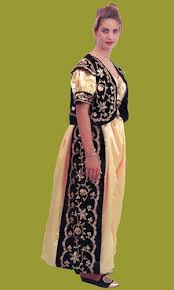Women's clothing is much more diverse than that of men. In the towns, the vast majority of young women have adopted the European style but women of a certain age, even in urban areas, often wrap a sefseri, white veil of silk or fine wool that covers the head with a blouse and baggy pants. These figures of women wearing sefseri is engrained in the traditional culture of Tunisia as much as the blue and white houses of Sidi Bou Said. In rural areas, women still wear brightly colored dresses, often in the Berber style and made of blue or red cotton, representing their region or their village. The fabric is opened on the side and is held at the waist with a belt and at the shoulders by two clasps. Women of all ages typically wear a massive amount of jewelry with the clothing and it is common to see women with tens, even hundreds of gold sovereigns, necklaces and other trimmings around their necks and from the sides of the headdress.
The festive ceremonial costumes differ somewhat across regions. In the Sahel, the centerpiece of the ceremonial dress is a dress draped in wool or cotton, drawn to a bodice embroidered with silk and silver, a velvet jacket decorated with gold, lace pants and a silk belt. Until the middle of the nineteenth century, the brides of the wealthy aristocracy of Tunis often wore a Kaftan cut in velvet, brocade or silk and richly embroidered with gold and enriched with precious stones. Nowadays, some marrying in Sousse and Hammamet still wear a kaftan with elbow-length sleeves, an open front, and varying in length from the knee to the mid calf. The richness and originality of the costumes are typically based less on the cut or the fabric as they are on woven patterns or embroidery.
Wearing the hijab is not widespread in Tunisia although the country has seen a relative increase since the early 2000s. Indeed, the state prohibited it in schools and in the government offices.


The festive ceremonial costumes differ somewhat across regions. In the Sahel, the centerpiece of the ceremonial dress is a dress draped in wool or cotton, drawn to a bodice embroidered with silk and silver, a velvet jacket decorated with gold, lace pants and a silk belt. Until the middle of the nineteenth century, the brides of the wealthy aristocracy of Tunis often wore a Kaftan cut in velvet, brocade or silk and richly embroidered with gold and enriched with precious stones. Nowadays, some marrying in Sousse and Hammamet still wear a kaftan with elbow-length sleeves, an open front, and varying in length from the knee to the mid calf. The richness and originality of the costumes are typically based less on the cut or the fabric as they are on woven patterns or embroidery.
Wearing the hijab is not widespread in Tunisia although the country has seen a relative increase since the early 2000s. Indeed, the state prohibited it in schools and in the government offices.
tunisian traditional clothese

 Blog RSS Feed
Blog RSS Feed Via E-mail
Via E-mail Twitter
Twitter Facebook
Facebook